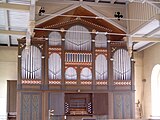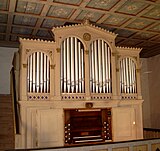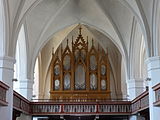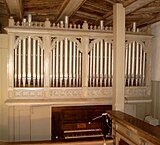Army car (organ building)
| Army car | |
|---|---|
| legal form | one-man business |
| founding | 1855 |
| resolution | 1935 |
| Seat | Klosterhäseler (until 1892), Bad Kösen (until 1896), and Weimar |
| Branch | Organ building |
Heerwagen was a German organ building company that was founded in 1855 and existed until 1935.
history
The company was founded by Wilhelm Heerwagen (1826–1875). Heerwagen was born on November 5, 1826 in Bad Blankenburg as the son of a master carpenter and learned the trade of organ builder in the workshop of Johann Friedrich Schulze in Paulinzella . Schulze's company was important for the implementation of new theoretical approaches in organ building, especially by Johann Gottlob Töpfer and, for example, manufactured an organ for the Crystal Palace at the 1851 World Exhibition in London.
In 1855 Heerwagen opened his own organ building workshop in Klosterhäseler and worked here with three journeymen. Numerous new organs were built in the workshop in today's federal states of Saxony-Anhalt, Thuringia and Brandenburg, many of which - over twenty in his home region between Saale and Unstrut alone - are still preserved today. They are characterized by solid craftsmanship and, for this time, rather conservative design of the disposition. In addition, repairs and organ modifications were carried out. After Wilhelm's early death on September 29, 1875, his son Emil (1857–1935) took over the business and continued to run it in Klosterhäseler until 1892. There he went bankrupt. In 1893 he resumed operations in Bad Kösen and continued the workshop in Weimar from 1896 until his death in 1935 . He was succeeded by organ builder Gerhard Kirchner (1907–1975).
The Klosterhäseler organ building museum is reminded of the company founded in Klosterhäseler.
List of works (selection)
| year | place | church | image | Manuals | register | Remarks |
|---|---|---|---|---|---|---|
| 1858 | Goldfinch | Village church | II / P | 13 | ||
| 1861 | Weischütz | Village church | I / P | 9 | ||
| 1868 | Wetzendorf (Karsdorf) | St. Kilian |

|
II / P | 15th | |
| 1868 | Stepenitz | Marienfließ monastery church | II / P | 17th | ||
| 1869 | Brat | St. Crucis |

|
II / P | 14th | |
| 1869 | Uichteritz | Village church | II / P | 16 | ||
| 1871 | Klosterhäseler | Village church | II / P | 13 | ||
| 1871 | Bad Bibra | Maria Magdalenen Church |

|
II / P | 24 | |
| 1872 | Zeitz (Aue-Aylsdorf) | Ev. church | II / P | 10 | ||
| 1873 | Steinbach ( Bad Bibra ) | Margaret Church |

|
I / P | 9 | |
| 1874 | Rothenberga | Village church |

|
II / P | 11 | |
| 1874 | Nauen | St. Jacobi |

|
II / P | 32 | |
| 1879 | Burkersroda | Village church |

|
II / P | 12 | |
| 1880 | Balgstädt | Village church | I / P | 7th | ||
| 1882 | Obhausen | St. Nikolai (ne) | I. | 5 | ||
| 1883 | Obermöllern ( Möllern ) | Nicolaikirche | II / P | 9 | ||
| 1889 | Kalbitz ( Bad Bibra ) | Village church |

|
I / P | 8th | |
| 1892 | Langeneichstädt | St. Nikolai | II / P | 19th | ||
| 1903 | Bucha | St Michaelis | II / P | 16 | ||
| 1907 | Buchfart | Village church of our dear women | II / P | 12 |
literature
- Rolf Walther: Wilhelm and Emil Heerwagen - organ builders shape a region. For the 180th birthday of Wilhelm Heerwagen. In: Ars Organi . 54, 2006, no. 4, pp. 228-229.
- Rudi-Arnold Jung: The organ builders Heerwagen in Klosterhäseler, Bad Kösen and Weimar. Typescript in the Heerwagen organ building exhibition Klosterhäseler.
- Emil Heerwagen: Report, Dietsch & Brückner, Weimar, 1897




